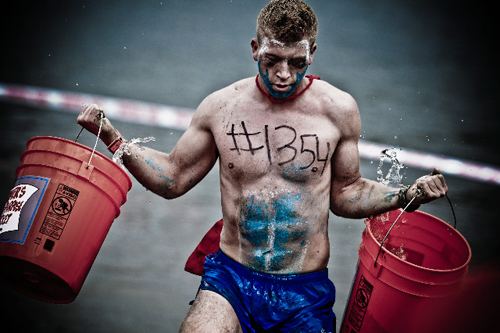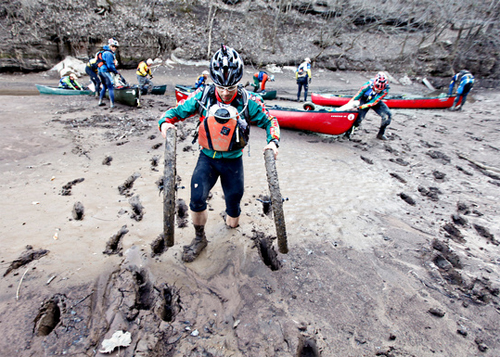“The hottest trend in adventure racing is negotiating obstacles like barbed wire and burning hay bales.” That quote comes from Outside magazine in reference to an article in the publication’s January edition, “American Gladiators,” which covers the rising trend of obstacle-course races like Muddy Buddy, the Spartan Race, Tough Mudder, and Warrior Dash. To anyone who has bushwhacked, mountain biked, paddled, and navigated with a map and a compass for hours or even days on a traditional adventure race like Primal Quest, the Wenger Patagonian Expedition, or Odyssey’s Endorphin Fix (myself included!), the “barbed wire and burning hay bales” reference is perplexing at best and perhaps insulting to dedicated “AR” athletes who have spent years honing wilderness skills and training their bodies for the rigors of an ultra-endurance sport.

To be sure, the Spartan Race, Tough Mudder, and their ilk are bonafide challenges. They are undeniably popular, too, attracting almost 1 million participants last year, according to the Outside story. But can they be called “adventure races,” and does this increasingly common categorization of mud/obstacle races dilute the definition of traditional AR?
Not so says Paul Angell, president of Checkpoint Tracker, an organization that oversees a national ranking system and runs a popular adventure race series in the United States. “To the man on the street, any event that involves racing and anything they consider adventurous is ‘adventure racing,’” Angell said. He continued, “worrying about [the categorization] is a fool’s errand because the horse has left the barn.”
But Joe Desena, co-founder of the Spartan Race series, disagrees with Angell, citing major differences that delineate an obstacle race and an adventure race. Desena comes from traditional adventure-racing roots, including experience in multiday wilderness events. In a blog post last month, “Adventure Racing vs. Obstacle Racing,” he writes that the two terms are often used interchangeably “to the detriment of race organizers and competitors alike.”

Desena continues, “when it comes right down to it, the only similarities that obstacle racing has with adventure racing is the running component and the use of obstacles.” In a race like the Spartan, participants face multiple military-inspired challenges the likes of crawling on their bellies uphill under barbed wire. Traditional adventure racing is more about deep wilderness, orienteering and navigation, teamwork (coed, four-person teams are the norm), route strategy, and managing exhaustion and sleep deprivation on checkpoint-laden courses that might take hours or even days to complete.
Checkpoint Tracker’s Angell, as noted, does not care so much about the categorization. But he agrees that the format and physical requirements put on participants of these two types of events differs widely, explaining that other than the fact that both take place outside there is not much in common. “Sure, some traditional adventure races include a mud pit,” Angell said. “Beyond that where exactly is the similarity? Navigation? Team format? Length? Disciplines?” His answer is a “no” to all points above.
Angell said obstacle races are easier than adventure races and the skill set required is less demanding. “If you can run, jump and climb you can show up at one of these obstacle races and you’re in.” Surprisingly, Desena agrees to an extent, writing that “certain adventure races involve a lot more hardship and deprivation than a two-hour obstacle race.”

But obstacle races vary in distance and challenge level, Desena said, from three-mile races with mud pits to half-marathons that include walls, burning debris, and electrically-charged barriers you need to avoid. “Nothing against adventure racing,” Desena wrote, “but a well-designed obstacle race will push, intimidate, and even break those brave enough to try it.”
As cited, almost 1 million people signed up for an obstacle race last year. This far outshines traditional AR, where big events might attract 100 people. Obstacle races typically measure sign-ups in the thousands. Desena explains the participation gap by writing about how “adventure races are only feasible for the top 5% of obstacle racers.” He said the requirement to be proficient at navigating, mountain biking, kayaking, running, and operating on very little sleep makes adventure racing “not for everyone” whereas almost anyone in good shape can sign up for an obstacle race and jog their way through a delineated course, confronting the obstacles at their own speed along the way.
Desena’s “not for everyone” comment is important. Participation in traditional adventure racing has hit a plateau. Conversely, things like Tough Mudder and Warrior Dash are huge and gaining steam each year. Desena plans to run 35 Spartan events in 2012, and the company is immensely more successful than anything in the wilderness-racing realm.

Paul Angell said the formula for success is obvious. “First and foremost, you don’t have to commit an entire weekend and a paycheck to participate [in an obstacle race] and I’m not sure if it’s more complicated than that.” He continued, “all you need is the will and a decent pair of trail runners.”
I asked Angell how adventure race directors might attract some of the people who do obstacle races to try AR. “I think adventure racing promoters should be going after these athletes with the message that when they’re ready to stop playing in the mud we’ve got something for them,” Angell said.
Traditional AR purists can see obstacle races as gimmicky. But barbed wire and burning hay bales aside, both sports — obstacle and adventure racing — can be bonafide physical and mental feats. Angell respects the success of obstacle races and thinks the world of adventure racing can learn a lot from the masses of people signing on to play in the mud. Overall, Desena notes that both genres can yield “a greater sense of satisfaction, reward, and much better stories” than traditional endurance sports like marathon running and triathlons. In the end, it’s the stories you come home with, born from those moments outside in the woods or on a mud-coated military wall, that will keep people coming back to face a challenge, push limits, and once again feel that primal pain.
—Stephen Regenold is founder and editor of www.gearjunkie.com. He wrote recently on the state of adventure racing in the article “Dysfunction and Dueling National Champs.”
